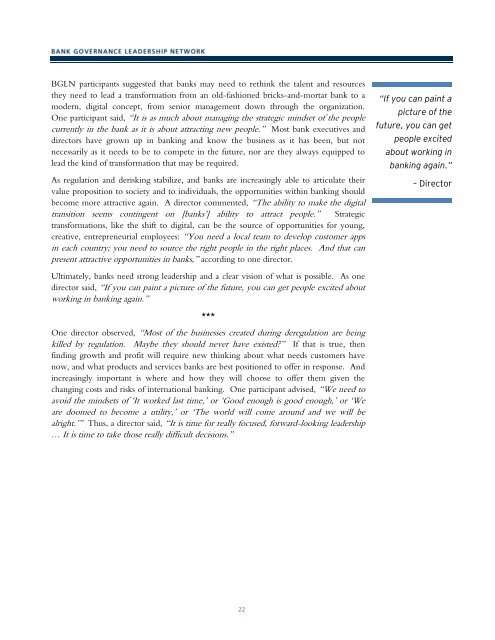Tapestry_EY_BGLN_Summit_View_The_future_of_global_banking-Dec14 (1)
You also want an ePaper? Increase the reach of your titles
YUMPU automatically turns print PDFs into web optimized ePapers that Google loves.
<strong>BGLN</strong> participants suggested that banks may need to rethink the talent and resources<br />
they need to lead a transformation from an old-fashioned bricks-and-mortar bank to a<br />
modern, digital concept, from senior management down through the organization.<br />
One participant said, “It is as much about managing the strategic mindset <strong>of</strong> the people<br />
currently in the bank as it is about attracting new people.” Most bank executives and<br />
directors have grown up in <strong>banking</strong> and know the business as it has been, but not<br />
necessarily as it needs to be to compete in the <strong>future</strong>, nor are they always equipped to<br />
lead the kind <strong>of</strong> transformation that may be required.<br />
As regulation and derisking stabilize, and banks are increasingly able to articulate their<br />
value proposition to society and to individuals, the opportunities within <strong>banking</strong> should<br />
become more attractive again. A director commented, “<strong>The</strong> ability to make the digital<br />
transition seems contingent on [banks’] ability to attract people.” Strategic<br />
transformations, like the shift to digital, can be the source <strong>of</strong> opportunities for young,<br />
creative, entrepreneurial employees: “You need a local team to develop customer apps<br />
in each country; you need to source the right people in the right places. And that can<br />
present attractive opportunities in banks,” according to one director.<br />
Ultimately, banks need strong leadership and a clear vision <strong>of</strong> what is possible. As one<br />
director said, “If you can paint a picture <strong>of</strong> the <strong>future</strong>, you can get people excited about<br />
working in <strong>banking</strong> again.”<br />
***<br />
One director observed, “Most <strong>of</strong> the businesses created during deregulation are being<br />
killed by regulation. Maybe they should never have existed?” If that is true, then<br />
finding growth and pr<strong>of</strong>it will require new thinking about what needs customers have<br />
now, and what products and services banks are best positioned to <strong>of</strong>fer in response. And<br />
increasingly important is where and how they will choose to <strong>of</strong>fer them given the<br />
changing costs and risks <strong>of</strong> international <strong>banking</strong>. One participant advised, “We need to<br />
avoid the mindsets <strong>of</strong> ‘It worked last time,’ or ‘Good enough is good enough,’ or ‘We<br />
are doomed to become a utility,’ or ‘<strong>The</strong> world will come around and we will be<br />
alright.’” Thus, a director said, “It is time for really focused, forward-looking leadership<br />
… It is time to take those really difficult decisions.”<br />
“If you can paint a<br />
picture <strong>of</strong> the<br />
<strong>future</strong>, you can get<br />
people excited<br />
about working in<br />
<strong>banking</strong> again.”<br />
– Director


